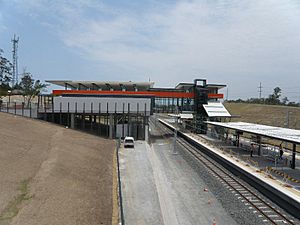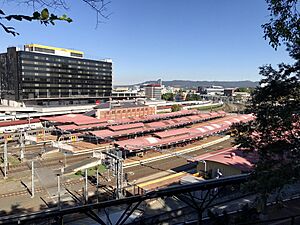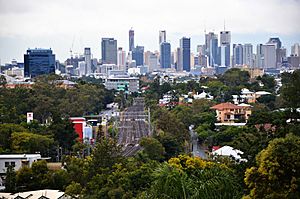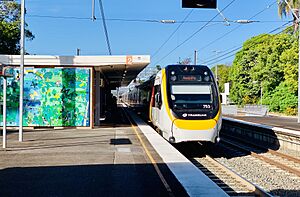Railways in South East Queensland facts for kids
Quick facts for kids Railways in South East Queensland |
|
|---|---|
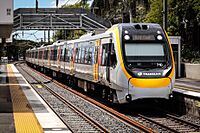
NGR 710 at Yeronga in 2018.
|
|
| Info | |
| Owner | Queensland Rail |
| Locale | Brisbane |
| Transit type | Suburban rail |
| Number of lines | 12 |
| Number of stations | 154 plus 3 under construction |
| Chief executive | Katarzyna Stapleton |
| Headquarters | Brisbane |
| Operation | |
| Began operation | 1865 |
| Operator(s) | Queensland Rail |
| Technical | |
| System length | 689 km (428 mi) |
| Track gauge | 1,067 mm (3 ft 6 in) |
| Electrification | 25 kV 50 Hz AC overhead lines |
| Top speed | 140 km/h (87 mph) |

Imagine a huge network of train lines in South East Queensland, all centred around Brisbane, the capital city of Queensland, Australia. This network helps people travel and moves goods around.
Most of the passenger trains you'll see are run by Queensland Rail. They operate trains for people travelling short distances within the city (suburban) and longer trips between cities (interurban). There are also long-distance trains that go to other parts of Queensland. For moving goods, companies like Aurizon and Pacific National use the railway lines.
Queensland Rail has 10 suburban and two interurban lines in South East Queensland. All these lines use electricity to power the trains. The network starts in the middle of Brisbane city and reaches places like Gympie in the north, Varsity Lakes in the south, Rosewood in the west, and Cleveland near Moreton Bay in the east.
Each train line has its own colour and name. You'll see these on maps, posters, and timetables. There are 153 train stations across the network! Queensland Rail calls this system either the 'South East Queensland (SEQ) network' or the 'Citytrain network'. All the train services and tickets are managed by a Queensland government group called Translink.
In the 2022–23 financial year, Queensland Rail trains had over 42.86 million passenger trips. This makes it the fourth busiest suburban train network in Australia, after Sydney, Melbourne, and Perth.
Contents
A Journey Through Time: How Queensland's Railways Began
Building the First Tracks
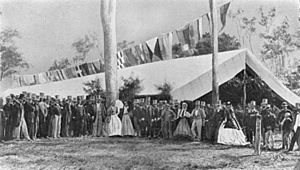
The very first railway line in Queensland didn't actually go to Brisbane! It ran from Ipswich to Grandchester and opened in July 1865. The train line connecting to Brisbane wasn't finished until July 1875, when the Albert Bridge opened.
Over the next few years, more lines were built. In 1882, lines opened from Brisbane to Sandgate and Ascot. The first part of the North Coast line opened to Petrie in 1888. This line later connected to Gympie in 1891, creating a long train route to Mount Perry.
Some smaller lines were also built, like the one from Caboolture to Woodford (1909) and Kilcoy (1913), but these are now closed. A line from Monkland (near Gympie) to Brooloo opened in 1915.
In 1885, a line opened from the first South Brisbane station to Beenleigh. This line was later extended to Southport in 1889 and Tweed Heads, New South Wales in 1903. However, the part of the line past Beenleigh closed in 1964.
A line connecting Park Road station to Cleveland was finished in 1889. Part of this line was closed for a while but has since been rebuilt. A new South Brisbane station was built in 1891. This station became important because it connected to the standard-sized train line from Grafton (1930) and Sydney (1932).
In 1978, a special track that could handle two different train sizes was built from South Brisbane across the Brisbane River to Roma Street. A freight line opened in 1980 from near Lindum station to the Port of Brisbane at Fisherman's Island. This line was later upgraded to handle both train sizes and extended in the 1990s.
Other lines that opened include the Beaudesert line (1888, closed 1996) and the Canungra line (1915, now closed). The line from Roma Street was extended to Central in 1889 and to Brunswick Street in 1890. The Ferny Grove line opened in 1899.
Making Trains Electric: A Power-Up Story
Plans to make the suburban train network electric were first approved in 1950. However, a change in the state government in 1957 stopped the project. It wasn't until the 1970s that the idea of electric trains came up again. The first part of the new electric system, from Darra to Ferny Grove, opened on 17 November 1979.
The entire electric network was finished by 1988, and more lines have been added or extended since then. New trains were also bought. At first, the services were simply called Queensland Rail, but the name Citytrain was introduced in 1995.
Adding More Tracks for More Trains
To handle more trains and passengers, some parts of the Brisbane rail network needed extra tracks. This is called "duplication."
In 2004, the Queensland Government announced plans to add more tracks to the Gold Coast line between Ormeau and Coomera stations. From 2008 to 2010, work was done to duplicate tracks between Darra and Corinda stations. This work also included a connection to the Springfield line and upgrades to Oxley and Darra stations. In 2010, money was set aside to duplicate the line between Keperra and Ferny Grove.
More Tracks for Busy Lines
- Beenleigh line: A third track was added between Salisbury and Kuraby stations, which is about 9.5 km (5.9 mi) long. This extra track helps Gold Coast line trains run with fewer delays. Seven stations along this section were also greatly improved. This project was completed in 2008.
- Ferny Grove line: A second track was added between Mitchelton and Keperra stations. This included upgrades to Oxford Park and Grovely stations. With two platforms, more trains can run during busy times, and trains don't have to wait as long. Other improvements included lifts, footbridges, and new station buildings to make them easier for everyone to use. The line has also been duplicated further between Keperra and Ferny Grove, with an extra platform and parking at Ferny Grove.
- Gold Coast line: The line between Ormeau and Coomera stations (6.7 km (4.2 mi)) was duplicated in 2006. The 16.6 km (10.3 mi) section between Helensvale and Robina stations was duplicated in 2008. This meant trains no longer had to wait at Helensvale.
- Ipswich line: About 5.2 km (3.2 mi) of track between Corinda and Darra stations was expanded to four tracks. This greatly increased the number of trains that could run, especially with the Springfield railway line branching off from Darra.
- Sunshine Coast line: About 13.7 km (8.5 mi) of track north of Caboolture station to Beerburrum station has been duplicated and straightened. New stations were also built at Elimbah and Beerburrum. This work started in 2007 and was finished in 2009. Plans are in place to duplicate another 17 km (11 mi) of track from Beerburrum to Landsborough, with construction planned to start in 2020.
New Train Lines and Extensions
Airport Line

The Airport train line opened in May 2001. This line was built and is operated by a private company called Airtrain Citylink. After 35 years, they will hand the entire line over to the Queensland Government. Airtrain Citylink hired other companies to build and maintain the line, and Queensland Rail provides the trains.
Gold Coast Line
In July 2007, the Queensland Government announced plans to extend the Gold Coast line. The first part was finished in 2009, taking the line to Varsity Lakes. There were ideas to extend it further to Tallebudgera, but that didn't happen. This is the first step in a plan to eventually extend the line all the way to the Gold Coast Airport. Future extensions, including stations at Tallebudgera, Elanora, and Tugun, are expected after the Cross River Rail project is finished.
The G:link light rail line on the Gold Coast also opened in July 2014.
Springfield Line
The Springfield railway line is a new line that branches off the Ipswich line at Darra railway station and goes to the Springfield area. This 26 km (16 mi) extension cost $475 million and was completed in December 2013.
Redcliffe Peninsula Line
The Redcliffe Peninsula railway line (also known as the Moreton Bay Rail link) is a suburban train line that extends about 27.5 km (17.1 mi) north-northwest from Brisbane central business district. It branches off the existing Caboolture line after Petrie railway station and goes to the Redcliffe peninsula. People had been talking about building this line since the 1970s, and land was bought in the 1980s, but construction didn't start until 2013. The line opened to passengers on 4 October 2016.
What's Next for Queensland's Trains?
Many upgrades and extensions are being planned or are already being built for the South East Queensland train network. For example, the Maroochydore railway line is planned to branch off the North Coast line at Beerwah and go through Caloundra to Maroochydore.
In 2011, the Queensland Government released a big transport plan called Connecting SEQ 2031. Its goal is to double the number of people using public transport in South East Queensland. This plan suggested several upgrades and new train lines, including:
- Cross River Rail
- The Gold Coast light rail
- A new high-frequency Brisbane subway in the city centre from Toowong to Bowen Hills
- A new North-west rail line branching from Cross River Rail at Alderley to Strathpine
Cross River Rail: A New Underground Link
|
In 2007, the government started studying how to improve train access under the Brisbane city centre. They looked at building an underground line from Park Road station to Woolloongabba, then across the Brisbane River to connect with the Exhibition railway line. This would include major new stations at Woolloongabba, Gardens Point/QUT, and in the city centre. This big project, called Cross River Rail, is now being built and is expected to open in early 2026. Work began in 2017 on this second train crossing for Brisbane, as the Merivale Bridge was getting too busy. The project includes almost six kilometres of new underground train tracks, three new underground stations at Boggo Road, Woolloongabba, and Albert Street. It also includes new underground platforms at Roma Street station and an upgrade to the existing Exhibition station. The new inner-city route will be used by the New Generation Rollingstock trains.|| |
Logan and Gold Coast Faster Rail
| The Logan and Gold Coast Faster Rail project is about upgrading the Beenleigh and Gold Coast Lines. It will add more tracks between Kuraby and Beenleigh, upgrade six stations, move three others, and make sure all road crossings go over or under the tracks. It will also add a new train control system from Salisbury to Varsity Lakes. |
Direct Sunshine Coast Rail Line
| The Direct Sunshine Coast Rail (DSC) is a brand new train line planned to go from Beerwah to Maroochydore. It will serve growing communities like Birtinya, Caloundra, Nirimba, Aroona, and Kawana on the southern Sunshine Coast. This new line will share space with the proposed Kawana Motorway for part of its route. There's also a plan for it to extend to the Sunshine Coast Airport in the future. The southern part of the line is mostly flat, allowing trains to travel as fast as possible through open areas and forests. |
Train Lines and Services
Queensland Rail runs 12 train lines across South East Queensland, all connected through the Brisbane city centre. Lines that share a colour on maps usually connect through the central city. The Exhibition line is a special service that runs only for events at the Brisbane Showgrounds. Keep in mind that some stations might appear on this list more than once if they serve multiple lines.
RailBus Services
Translink also runs several bus routes that follow old train lines or help out on lines that don't have many passengers. For example, to help with busy times on the single-track North Coast line north of Beerburrum, buses run on weekdays between Caboolture and Nambour.
Train Stations
There are 153 stations on the South East Queensland train network. The four main stations in Brisbane city are Roma Street, Brisbane Central, Fortitude Valley, and Bowen Hills. All suburban and interurban lines stop at these stations, making them the heart of the network.
Who Operates the Trains?
Passenger Services
The suburban and interurban passenger trains are run by Queensland Rail under the Citytrain brand. Translink helps to coordinate these services. For longer trips around the state, Queensland Rail operates trains under the Traveltrain brand. There's also a train service to Sydney in New South Wales, which is run by NSW TrainLink using their XPT trains.
In Brisbane, the number of passenger trips on the suburban network doubled between 1979 and 1989, reaching 50 million trips a year! By 1992, it had grown another 10%.
In 2009, Queensland Rail separated its passenger and freight businesses. The Citytrain brand was removed, and trains and stations started using the main Queensland Rail brand. However, in 2017, a government report brought the Citytrain network name back. This was because the name was still well-known in Brisbane.
The announcements you hear on the passenger trains are voiced by Ross Newth.
Freight Services
Aurizon handles most of the freight services, using both the standard-sized tracks (1,435 mm (4 ft 8 1⁄2 in)) and the narrower tracks (1,067 mm (3 ft 6 in)). Pacific National also operates freight services on both types of tracks.
The main place where train freight is handled is in Acacia Ridge, a southern suburb of Brisbane. This is located near the Beenleigh suburban line and connects to the line from New South Wales. A freight line opened in 1980 from Acacia Ridge to Fisherman's Island and the Port of Brisbane. This line runs next to the Beenleigh line for some distance. In 1997, this line was upgraded to handle both standard and narrow-gauge trains, meaning trains could travel directly from the port across the New South Wales border without having to change trains.
About four million tonnes of goods are moved by train from outside South East Queensland to places within it each year. Another 1.1 million tonnes go to other states. One of the biggest things moved by train is coal, which travels along the Western Line to the Swanbank Power Station and the Port of Brisbane.
The intermodal terminal at Fisherman Islands opened in 1994. Other places where train freight has been handled include South Brisbane, Park Road, Yeerongpilly, Clapham, and Salisbury.
Fares and Tickets
The train network in South East Queensland uses a fare system with eight pricing zones, managed by Translink. You can pay for your train trips using a special contactless card called a go card. To use it, you just tap your card on a card reader at the start and end of your journey, and when you switch between different services.
Train Fleet
All the trains used on the Queensland Rail City Network are electric and have air conditioning.
Here are some of the types of trains you might see:
- Electric Multiple Unit (EMU) – 28 are still in service (88 were built).
- Suburban Multiple Unit (SMU)
- 200 Series (SMU200) – 12 in service.
- 220 Series (SMU220) – 30 in service.
- 260 Series (SMU260) – 36 in service.
- Interurban Multiple Unit (IMU)
- 100 Series (IMU100) – 10 in service.
- 120 Series (IMU120) – 4 in service.
- 160 Series (IMU160) – 28 in service.
- New Generation Rollingstock
- 700 Series – 75 in service.
- Queensland Train Manufacturing Program (QTMP) (being built)
- 65 new six-car Olympic SMUs made by Downer/Hyundai Rotem.
All these trains are "electric multiple units," meaning they are powered by electricity and have a driver's cabin at both ends. This allows them to travel in either direction without turning around. The only exception was some older EMU trains (EMU60 to EMU79) which only had a cab at one end. Most EMU, SMU, and IMU trains are made up of three cars.
Sometimes, suburban trains are used on interurban lines if other trains with toilets are not available. While this helps with operations, these suburban trains don't have the same features as the IMU, ICE, or NGR units, like toilets or comfortable high-backed seats.
The 260 Series SMU, 160 Series IMU, and the NGR trains all offer free Wi-Fi on board, with a limit of 20MB per use.
75 new six-car New Generation Rollingstock trains were ordered in 2014 and arrived between late 2015 and late 2019. A new place to maintain these trains was built at Wulkuraka. The first NGR train started service on 11 December 2017.
To handle the expected increase in passengers, plans were announced in 2020 to get 20 new electric trains. The government is also thinking about ordering an additional 45 electric trains, which could mean up to 65 new electric trains in the next ten years.
Images for kids



